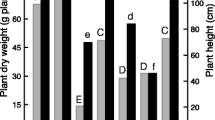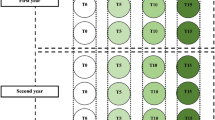Abstract
The olive mill wastewater (OMW) properties impose substantial practical and fiscal difficulties for effective management and dumping. A feasible and practical option is a regulated spreading of OMW into the soil. This study aimed to investigate the sustainable reuse of OMW through land application to enhance soil quality and wheat growth performance under rain-fed conditions. OMW was spread at 20, 40, 60, 80, and 120 m3 ha−1 at two sites. Soil physical and chemical properties were measured after OMW application and after harvest. Wheat growth performance and leaf nutrient content were determined. This study revealed no deleterious influence of OMW application on soil properties and wheat growth at the two locations for all OMW application doses. The OMW land spreading improved significantly wheat growth by increasing the biological yield (BYLD) (8.4 to 36.5%), grain yield (GYLD) (20.1 to 79.4%), and harvest index (HI) (4.2 to 60.2%). Based on the measured soil chemical parameters and wheat grain yield, we can suggest that OMW application rate at 60 m3 ha−1 could improve significantly wheat growth without significant negative impact on soil properties. In conclusion, we recommend using OMW as suggested in this study for wheat. However, still the long-term application of OMW assessment and local legislative adaptation of saving use are necessary.

Similar content being viewed by others
References
Al-Khatib, A., Aqra, F., Al-Jabari, M., Yaghi, N., Basheer, S., Sabbah, I., Al-Hayek, B., & Mosa, M. (2009). Environmental pollution from olive production. Bulgarian Journal of Agricultural Science, 15, 544–551.
Association of Official Analytical Chemists (AOAC). (1990). Official methods of analysis. Washington D.C: AOAC.
Ayoub, S. (2017). Management of olive by-products in Jordan. Ensuring sustainability of Jordanian olive sector Conference, Amman, Jordan.
Azzam, M. O., Al-Malah, K., & Abu-Lail N. (2004). Dynamic Post-treatment Response of Olive Mill Effluent Wastewater Using Activated Carbon. Part A: Toxic/Hazardous Substances and Environmental Engineering A39. Journal of Environmental Science and Health, (1), 269–280.
Belaqziz, M., Lakhal, E. K., Mbouobda, H., & El-Hadrami, I. (2008). Land spreading of olive mill wastewater: effect on maize (Zea maize). Journal of Agronomy, 7, 297–305.
Belqziz, M., El-Abbassi, A., Lakhal, E., Agrafioti, E., & Galanakis, C. (2016). Agronomic application of olive mill wastewater: effect on maize production and soil properties. Journal of Environmental Management, 171, 158–165.
Bisdom, E. B. A., Dekker, L. W., & Schoute, J. F. T. (1993). Water repellency of sieve fractions from sandy soils and relationships with organic material and soil structure. Geoderma, 56, 105–118.
Blackford, J. J., & Chambers, F. M. (1993). Determining the degree of peat decomposition for peat-based palaeoclimatic studies. International Peat Journal, 5, 7–24.
Box, J. D. (1983). Investigation of the Folin–Ciocalteu phenol reagent for the determination of polyphenolic substances in natural waters. Water Research, 17, 511–525.
Brunetti, G., Senesi, N., & Plaza, C. (2007). Effects of amendment with treated and untreated olive oil mill wastewaters on soil properties, soil humic substances and wheat yield. Geoderma, 138, 144–152.
Buchmann, C., Felten, A., Peikert, B., Muñoz, K., Bandow, N., Dag, A., & Schaumann, G. E. (2015). Development of phytotoxicity and composition of a soil treated with olive mill wastewater (OMW): an incubation study. Plant and Soil, 386, 99–112.
Chapman, H.D. & Pratt, P.F. (1982). Methods of analysis for soils, plants and waters. Division of Agricultural Sciences, University of California, Berkeley, USA.
Chartzoulakis, K., Psarras, G., Moutsopoulou, M., & Stefanoudaki, E. (2010). Application of olive mill wastewater to a Cretan olive orchard: effects on soil properties, plant performance and the environment. Agriculture, Ecosystems & Environment, 138, 293–298.
Department of Statistics. (2016). Annual report. Amman, Jordan.
Food and Agricultural Organization of the United Nations Statistics Division (FAOSTAT). (2019). ProdSTAT. Crops, olive oil.
Galliou, F., Markakis, N., Fountoulakis, M. S., Nikolaidis, N., & Manios, T. (2018). Production of organic fertilizer from olive mill wastewater by combining solar greenhouse drying and composting. Waste Management, 75, 305–311.
Gargouri, K., Ben Rouina, B., Rhouma, A., Ayadi, M., Abichou, M. & Bentaher, H. (2013). Case study of an integrated system for olive mill by-products management in Sfax region in Central Tunisia. In : Arcas, N., F.N. Arroyo López, J. Caballero, R. D 'Andria, M. Fernández, R. Fernandez Escobar, A. Garrido, J. López-Miranda, M. Msallem, M. Parras, L. Rallo, & R. Zanoli (Ed.), Present and future of the Mediterranean olive sector (pp. 75-84). Zaragoza, CIHEAM /IOC, (Options Méditerranéennes: Série A. Séminaires Méditerranéens; n°106),
Gonzalez-Vila, F. J., Verdejo, T., Del Rio, J. C., & Martin, F. (1995). Accumulation of hydrophobic compounds in the soil lipidic and humic fractions as result of a long term land treatment with olive oil mill effluents. Chemosphere, 31(7), 3681–3686.
Inglezakis, V. J., Moreno, J. L., & Doula, M. (2012). Olive oil waste management EU legislation: current situation and policy recommendations. International Journal of Chemical and Environmental Engineering Systems, 3(2), 65–77.
Kavvadias, V., Komnitsas, K., & Doula, M. (2011). Long term effects of olive mill wastes disposal on soil fertility and productivity. In K. B. Satinder (Ed.), Hazardous materials: types, risks and control (pp. 433–471). Nova Science Publishers, Inc.
Kavvadias, V., Doula, M., Papadopoulou, M., & Theocharopoulos, S. (2015). Long-term application of olive-mill wastewater affects soil chemical and microbial properties. Soil Research, 53, 461–473.
Klute, A. (1986). Methods of soil analysis. Madison: ASA SSSA.
Lanza, B., Gabriella, D., Serio, M., & Di Giovacchino, L. (2017). Long-term spreading of olive mill wastewater on olive orchard: effects on olive production, oil quality, and soil properties. Commun. Communications in Soil Science and Plant Analysis, 48, 2420–2433.
Ligęza, S., & Smal, H. (2003). Accumulation of nutrients in soils affected by perennial colonies of piscivorous birds with reference to biogeochemical cycles of elements. Chemosphere, 52, 595–602.
Lo’pez-Pin’eiro, A., Albarra’n, A., RatoNunes, J. M., Pena, D., & Cabrera, D. (2011). Cumulative and residual effects of two-phase olive mill waste on olive grove production and soil properties. Soil Science Society of America Journal, 75(3), 1061–1069.
Magdich, S., Jarboui, R., Ben Rouina, B., Boukhris, M., & Ammar, E. (2012). A yearly spraying of olive mill wastewater on agricultural soil over six successive years: impact of different application rates on olive production, phenolic compounds, phytotoxicity and microbial counts. Science of the Total Environment, 430, 209–216.
Mahmoud, M., Janssen, M., Haboub, N., Nassour, A., & Lennartz, B. (2010). The impact of olive mill wastewater application on flow and transport properties in soils. Soil and Tillage Research, 107, 36–41.
McNamara, C. J., Anastasiou, C. C., O’Flaherty, V., & Mitchell, R. (2008). Bioremediation of olive mill wastewater. International Biodeterioration and Biodegradation, 61, 127–134.
Mechri, B., Ben Mariem, F., Baham, M., Ben Elhadj, S., & Hammami, M. (2008). Change in soil properties and the soil microbiological community following land spreading of olive mill wastewater affects olive trees key physiological parameters and the abundance of arbuscular mycorrhizal fungi. Soil Biology & Biochemistry, 40, 152–161.
Mekki, A., Dhouib, A., & Sayadi, S. (2013). Review: effects of olive mill wastewater on soil properties and plant growth. The International Journal of Recycling of Organic Waste in Agriculture, 2, 15.
Ministry of Agriculture. (2016). Annual report. Amman, Jordan.
Mohawesh, O. (2013). Assessment of pedotransfer functions (PTFs) in predicting soil hydraulic properties under arid and semi arid environments. Jordan Journal of Agricultural Sciences, 9(4), 475–492.
Mohawesh, O., Mahmoud, M., Janssen, M., & Lennartz, B. (2014). Effect of irrigation with olive mill wastewater on soil hydraulic and solute transport properties. International journal of Environmental Science and Technology, 11, 927–934.
Olsen, S.R. & Sommers, L.E. (1982). Phosphorus. In: A.L. Page, D.R. Keeney, D.E. Baker, R.H. Miller, Jr. Roscoe Ellis, J.D. Rhoades (Ed.), Methods of soil analysis, Part 2. Chemical and microbiological properties (pp. 403–429). Agronomy Monograph No. 9. Soil Science Society of America, Madison,
Ouzounidou, G., & Asfi, M. (2012). Determination of olive mill wastewater toxic effects on three mint species grown in hydroponic culture. Journal of Plant Nutrition, 35(5), 726–738.
Paredes, C., Cegarra, J., Roig, A., Sanchez-Monedero, M. A., & Bernal, M. P. (1999). Characterization of olive mill wastewater (alpechin) and its sludge for agricultural purposes. Bioresource Technology, 67, 111–115.
Rusan, M., Albalasmeh, A., & Malkawi, H. (2016). Treated olive mill wastewater effects on soil properties and plant growth. Water, Air, and Soil Pollution, 227, 135–145.
Saadi, I., Laor, Y., Raviv, M., & Medina, S. (2007). Land spreading of olive mill wastewater: effects on soil microbial activity and potential phytotoxicity. Chemosphere, 66, 75–83.
Saadi, I., Raviv, M., Berkovich, S., Hanan, A., Aviani, I., & Laor, Y. (2013). Fate of soil-applied olive mill wastewater and potential phytotoxicity assessed by two bioassay methods. Journal of Environmental Quality, 42, 1791–1801.
Sierra, J., Marti, E., Montserrat, G., Cruanas, R., & Garnu, M. A. (2001). Characterisation and evolution of a soil affected by olive oil mill wastewater disposal. Science of the Total Environment, 279, 207–214.
Singleton, V. L., Orthofer, R., & Lamuela-Raventós, R. M. (1999). Analysis of total phenols and other oxidation substances and antioxidants by means of Folin-Ciocalteu reagent. Methods in Enzymology, 299, 152–178.
Tarchitzky, J., Lerner, O., Shani, U., Arye, G., Lowengart-Aycicegi, A., Brener, A., & Chen, Y. (2007). Water distribution pattern in treated wastewater irrigated soils: hydrophobicity effect. European Journal of Soil Science, 58, 573–588.
Walkley, A., & Black, A. (1934). An examination of the Degtjaeff method for determining soil organic matter, and a proposed modification of the chromic acid titration method. Soil Science, 37, 29–38.
Wallach, R., Ben-Arie, O., & Graber, E. R. (2005). Soil water repellency induced by long term irrigation with treated sewage effluent. Journal of Environmental Quality, 34, 1910–1920.
Funding
This work is gratefully funded by the scientific research fund, Jordan Ministry of Higher Education (No. WE/2/02/2014).
Author information
Authors and Affiliations
Corresponding author
Additional information
Publisher’s Note
Springer Nature remains neutral with regard to jurisdictional claims in published maps and institutional affiliations.
Rights and permissions
About this article
Cite this article
Mohawesh, O., Al-Hamaiedeh, H., Albalasmeh, A. et al. Effect of Olive Mill Wastewater (OMW) Application on Soil Properties and Wheat Growth Performance Under Rain-Fed Conditions. Water Air Soil Pollut 230, 160 (2019). https://doi.org/10.1007/s11270-019-4208-8
Received:
Accepted:
Published:
DOI: https://doi.org/10.1007/s11270-019-4208-8




